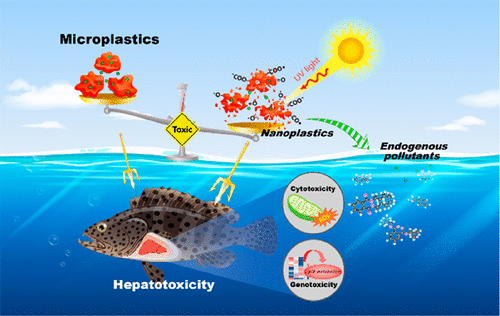当前位置:
X-MOL 学术
›
Environ. Sci. Technol.
›
论文详情
Our official English website, www.x-mol.net, welcomes your
feedback! (Note: you will need to create a separate account there.)
Photodegradation Elevated the Toxicity of Polystyrene Microplastics to Grouper (Epinephelus moara) through Disrupting Hepatic Lipid Homeostasis.
Environmental Science & Technology ( IF 10.8 ) Pub Date : 2020-03-31 , DOI: 10.1021/acs.est.9b07016 Xiao Wang 1 , Hao Zheng 1, 2 , Jian Zhao 1, 2 , Xianxiang Luo 1, 2 , Zhenyu Wang 3 , Baoshan Xing 4
Environmental Science & Technology ( IF 10.8 ) Pub Date : 2020-03-31 , DOI: 10.1021/acs.est.9b07016 Xiao Wang 1 , Hao Zheng 1, 2 , Jian Zhao 1, 2 , Xianxiang Luo 1, 2 , Zhenyu Wang 3 , Baoshan Xing 4
Affiliation

|
Microplastics (MPs) have caused increasing global concerns due to their detrimental effects on marine ecosystems. However, the role of photodegradation in altering toxicity of MPs to marine organisms is poorly understood. We therefore investigated the photolytic transformation of pristine polystyrene fragments (P-PS) by 60-day ultraviolet (UV) irradiation, and compared the toxicity of P-PS, photodegraded PS (PD-PS), and commercially available polystyrene microbeads (C-PS) to juvenile grouper (Epinephelus moara). Photodegradation reduced the size from ∼55.9 μm of P-PS to ∼38.6 μm of PD-PS, even produced nanoparticles (∼75 nm) with a yield of 7.03 ± 0.37% (w/w), and induced surface oxidation and formation of persistent free radicals (e.g., CO•, COO•). Also, endogenous pollutants (chemical additives and polymer fragments) were leached out. Thus, PD-PS had the highest growth inhibition and lipidosis-driven hepatic lesions of grouper, followed by P-PS and C-PS, which was mainly explained by increased hepatic bioaccumulation of MPs/NPs and released endogenous toxicants. Furthermore, oxidative stress-triggered mitochondrial depolarization, suppression of fatty acid oxidation and transport, and promotion of inflammation were identified as the key mechanisms for the enhanced hepatotoxicity after photodegradation. This work provides new insight into the potential hazard and harm of MPs in marine environments after photodegradation.
中文翻译:

光降解通过破坏肝脏脂质体内稳态而提高了聚苯乙烯微塑料对石斑鱼(石斑鱼(epinephelus moara))的毒性。
由于其对海洋生态系统的有害影响,微塑料(MPs)引起了全球关注。但是,人们对光降解在改变MP对海洋生物毒性方面的作用了解甚少。因此,我们研究了60天紫外线(UV)辐射对原始聚苯乙烯片段(P-PS)的光解转化,并比较了P-PS,光降解PS(PD-PS)和市售聚苯乙烯微珠(C- PS)到少年石斑鱼(Epinephelus moara)。光降解将P-PS的尺寸从约55.9μm减小到PD-PS的约38.6μm,甚至产生了纳米粒子(约75 nm),产率为7.03±0.37%(w / w),并诱导了表面氧化和形成P-PS。持久性自由基(例如,CO•,COO•)。此外,还滤出了内源性污染物(化学添加剂和聚合物碎片)。从而,PD-PS具有最高的石斑鱼生长抑制和脂质代谢驱动性肝损伤,其次是P-PS和C-PS,这主要是由于MPs / NPs的肝脏生物蓄积增加和内源性有毒物质释放所致。此外,氧化应激触发线粒体去极化,抑制脂肪酸氧化和运输,以及促进炎症被认为是光降解后增强肝毒性的关键机制。这项工作为光降解后海洋环境中MP的潜在危害和危害提供了新的见解。氧化应激引发的线粒体去极化,抑制脂肪酸氧化和运输以及促进炎症被认为是光降解后增强肝毒性的关键机制。这项工作为光降解后海洋环境中MP的潜在危害和危害提供了新的见解。氧化应激引发的线粒体去极化,抑制脂肪酸氧化和运输以及促进炎症被认为是光降解后增强肝毒性的关键机制。这项工作为光降解后海洋环境中MP的潜在危害和危害提供了新的见解。
更新日期:2020-03-24
中文翻译:

光降解通过破坏肝脏脂质体内稳态而提高了聚苯乙烯微塑料对石斑鱼(石斑鱼(epinephelus moara))的毒性。
由于其对海洋生态系统的有害影响,微塑料(MPs)引起了全球关注。但是,人们对光降解在改变MP对海洋生物毒性方面的作用了解甚少。因此,我们研究了60天紫外线(UV)辐射对原始聚苯乙烯片段(P-PS)的光解转化,并比较了P-PS,光降解PS(PD-PS)和市售聚苯乙烯微珠(C- PS)到少年石斑鱼(Epinephelus moara)。光降解将P-PS的尺寸从约55.9μm减小到PD-PS的约38.6μm,甚至产生了纳米粒子(约75 nm),产率为7.03±0.37%(w / w),并诱导了表面氧化和形成P-PS。持久性自由基(例如,CO•,COO•)。此外,还滤出了内源性污染物(化学添加剂和聚合物碎片)。从而,PD-PS具有最高的石斑鱼生长抑制和脂质代谢驱动性肝损伤,其次是P-PS和C-PS,这主要是由于MPs / NPs的肝脏生物蓄积增加和内源性有毒物质释放所致。此外,氧化应激触发线粒体去极化,抑制脂肪酸氧化和运输,以及促进炎症被认为是光降解后增强肝毒性的关键机制。这项工作为光降解后海洋环境中MP的潜在危害和危害提供了新的见解。氧化应激引发的线粒体去极化,抑制脂肪酸氧化和运输以及促进炎症被认为是光降解后增强肝毒性的关键机制。这项工作为光降解后海洋环境中MP的潜在危害和危害提供了新的见解。氧化应激引发的线粒体去极化,抑制脂肪酸氧化和运输以及促进炎症被认为是光降解后增强肝毒性的关键机制。这项工作为光降解后海洋环境中MP的潜在危害和危害提供了新的见解。











































 京公网安备 11010802027423号
京公网安备 11010802027423号